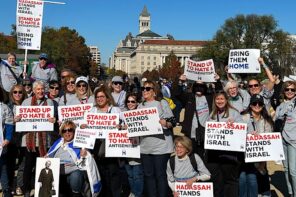In the weeks since an anti-immigration fanatic murdered eleven Jews gathered in a Pittsburgh synagogue, there have been numerous expressions of terror, sadness, anger, and shock, from both within and outside the Jewish community. The shooting conjures up horrors that ought to belong to the past, like European anti-Semitism, pogroms, and the Holocaust. In our current political environment, we might recall the more familiar brands of white nationalist rhetoric and abuse of indigenous peoples, foreigners, immigrants, and minorities. But many of us thought that “we” as a collective had overcome these curses, fought them back and learned to do better. According to the Anti-Defamation League’s Jonathan Greenblatt, “It is simply unconscionable … and unthinkable that it would happen in the United States of America in this day and age.”
This reaction to violence reveals something important about our thinking. We not only denounce such violence as wrong, but we perceive it as belonging rightfully to a past that’s dead and buried. Part of our shock is that the past seems to have erupted into the present, which is a critical misunderstanding of the hold such violence has, and the ways in which the past, present, and future are intertwined. The ghosts of racism—anti-Semitic and otherwise—are not external to us. They live among us, and within us. Like the rings of a tree, the past inhabits us as a record of what has happened and as a marker for what’s changed. But at the same time, it’s the indispensable core of what is yet to come.
In the late 1930s critical theorist Walter Benjamin pointed out that people’s surprise that anti-Semitic violence was “still” possible in his own day and age was due to the tendency to take progress for granted, and to our perception of time as a linear path in which the future is always an improvement. It’s true that in the contemporary United States Jews are neither stifled by the kinds of discrimination they faced in the early twentieth century, nor are they the victims of regular police violence or the more insidious forms of structural violence to which black, native, and other marginalized Americans are subject daily.
But to suggest that the shooting in Pittsburgh is an aberration is inadequate. It’s not that particular forms of hatred are eternal—they are not, as Shaul Magid argued recently here on RD—but rather that the complex and hierarchical societies in which we live depend on getting us to think in terms of particular kinds of distinctions.
We tend to think about both identity and time in terms of fixed categories; we are different from them, and the past is different from the present. But in fact, we perceive otherness and time as being fundamentally connected. We often differentiate ourselves by thinking about some kinds of others as belonging to the past—they are primitive and irrational, and we are not like them. We have progressed beyond their ways of thinking and behaving. We used to be like that, but have left that past behind. As anthropologist Johannes Fabian has pointed out, when we continue to observe certain ideas or behaviors in other living communities we label them as “backward”; those people who “still” live in thatched huts, for example, or who keep their women from voting or driving.
Philosopher Jacques Derrida approached this question differently. He said that the question is not about how to characterize the other’s difference from the self; it’s about the “non-contemporaneity of present time with itself.” If the present is reality, he writes, then both past and future seem to be unreality; the past is gone, and the future is yet to be. But our pasts are not gone. They are what constitute us as selves in the present. When we lose sight of that fact and perceive the otherness of our pasts as something that is not-now—not appropriate to co-exist with us in the present—we ignore the possibility of its reappearance.
In other words, parts of the past that seem to intrude into the present are indications that there can be no permanent consignment of our previous collective selves to the grave. The past lingers with us in the now as an inheritance that’s central to our present selves, and therefore represents a capacity for return.
Eric K. Ward writing for Political Research Associates reminds us of one way our pasts and presents are intertwined, noting that, in the United States, anti-Semitism “forms the theoretical core of White nationalism.” Since white supremacist ideology imagines Black people as an “inferior race,” any social or political gains they achieve—through the Civil Rights movement or via the election of a Black president—must be attributed to someone else’s efforts. The white supremacist imaginary frames Jews as a powerful secret cabal manipulating the national and global political and economic order according to their own interests.
This kind of thinking, of course, is precisely what animated the historical Jewish Question: what is the place of the Jews in Christendom (and in Europe)? It raised debates about the possibility of converting Jews to Christianity or assimilating them to full citizenship in modern nation-states. It asked whether, as a collective, they could ever be trusted or would forever be strangers, foreigners, and therefore not quite like “us.”
Questions such as these are now being replayed in contemporary Europe with respect to Muslims and migrants. The ghosts of the historical Jewish Question are now incarnated as the Muslim Question and the refugee question, even as it remains again and still the Jewish Question—one of the specters at the core of European and American identity.
We band together in demonstrations and write op-eds against the mass killings that punctuate contemporary American life, proclaiming that we will triumph over this evil. This is both a rallying cry and a form of sustenance. But it’s deceptive. There can be no permanent triumph over evil. We add to that evil rather than resist it when we fail to acknowledge that the past lives through us as our taken-for-granted social and political structures relentlessly renew themselves in our everyday lives.
How should we respond to the horrors of our own day and age, when quiet neighbors might suddenly reveal themselves to be hate-filled strangers with assault weapons, forcing their way into our houses of worship? “Arm yourselves!” some people say. Make sure there is a guard at the door of your synagogue, your church, your mosque, your place of sanctuary and refuge. Those armed guards might stand at the front door of a building, or they may be the army and national guard that stand watch at the nation’s borders. For some, Pittsburgh reemphasizes the need for a militarily fortified nation-state as a refuge for Jews; a place they (we) can go when the world turns again, still.
But the armed guards we place in the line of fire at our doorsteps and our borders are our own sons and daughters. Israel lives with the same ghosts. Framed as a solution to the problem of racialization, it is also racialization’s offspring, reproducing the boundaries between groups who trace their origins to different pasts.
The specter of this genealogical imagination is one of the most frightful ghosts that haunts us all. Anti-Semitism is foundational to white supremacist nationalism, but also to Zionist nationalism. This is one of the most important keys to understanding our contemporary social and political context. We try to think of Jewishness as a variety of religion: a set of traditions of belief and ritual that people can choose to adopt or abandon without legal consequence. But the European imagination of the Jew has long conflated their identity in ways that do not allow for choice. Jews are considered a nation, a people, or a race, regardless of how they pray and even if they consider themselves atheists.
The historical Jewish Question did not end in Europe. The removal of the Jews from Europe—their near elimination and their quest for self-determination—also transferred the Jewish Question into the heart of the Arab people of Palestine with devastating outcomes for Palestinians. The Jewish Question is the Palestinian Question. It is the Muslim Question. It is the Migrant Question and the Refugee Question. These are all questions that can be traced to the same historical conditions which continue to haunt us.
They are the question of how “we”—whoever we are—define the limits of our own identity and the limits to which we can imagine extending it to encompass Others. These questions do not disappear. We do not triumph over them. Instead, we wrestle with them with words and images, with walls and bullets, in shifting ways and in new circumstances, in every new day and age.
This essay is part of a broader collaborative project called Theory and Forgetting: The Jewish Question Again. See our forthcoming paper, “Time and the Spectral Other: Demonstrating Against Unite the Right 2,” in Anthropology Today.




